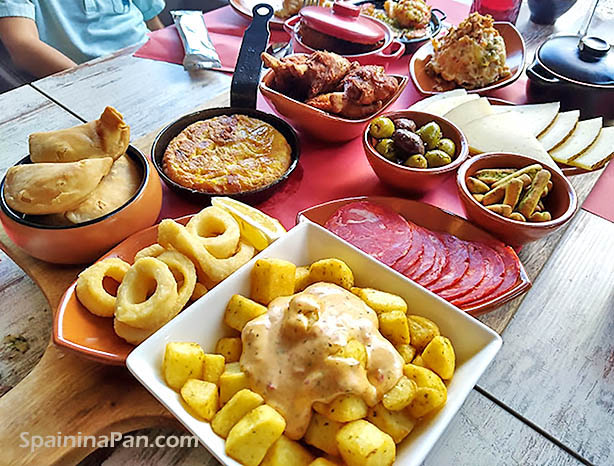- HOME
- About Me
I'm Edu Valor - Let's go Inside Spain's Authentic Kitchen
Hi, my name is Edu Valor and Spain in a Pan is my life and culinary journey since childhood. Consider it your insider's guide to Spanish cuisine, with tradition and authenticity as the common thread throughout the site.
 Cooking an authentic paella Valenciana.
Cooking an authentic paella Valenciana.
My Spanish roots introduced me to a rich and diverse kitchen, shaped by the regional diversity and history of the Iberian Peninsula.
There's something special about those whitewashed villages, between hills surrounded by vineyards and olive trees.
Walking down the narrow streets, you can catch the appetizing aromas from local restaurants. This is one of the reasons people are drawn to Spain — to taste diverse dishes with exotic, bold flavors.
My family is fairly large, centered around Seville (one of the country's culinary hubs) and spread across Spain in places like Valencia, Irun, and Madrid.
There’s an openness and sense of freedom in my country that I deeply cherish, and I'd gladly share that with you.
A little More About Me, Chef Edu!
I’m passionate about cooking Spanish food, always focused on its authentic flavors. My goal is to bring you nothing less than exquisite dishes from my home country. My recipes are the real deal!
As a teenager, I was already experimenting with sweets and discovering new ones.
There was one time when I opened the fridge, only to find the desserts had mysteriously disappeared. Yes, I had a knack for cooking, much like my cheeky sisters.
We were, and still are, competitive when it comes to food.
Even in college, a little voice kept reminding me that becoming a chef might be another path, besides film school.
Meet Isabel – My Sister and the Lead Chef
She's the youngest of the three sisters. With our shared passion for food, it was only a matter of time before one of us opened a restaurant—and that’s exactly what happened!
"Pasión y Sabor" was the brainchild of Isabel and her partner, Johan.
 Isabel showing a mixed tapas dish.
Isabel showing a mixed tapas dish.
Their goal is to create dishes that’s both delicious and artful, driven by hard work and dedication. It’s what keeps customers coming back.
This all happens in Belgium, where my parents moved to in the '60s. Ingredients have always been accessible, no matter where we live.
Local produce is excellent, and if we can create delicious food, so can you! There are specialized (online) stores in our region for those uncommon ingredients, or we simply bring them back from trips to Spain.
Taste and How I Tickle Your Taste Buds!

For people to truly enjoy food, taste and fresh ingredients are everything. You can’t have one without the other.
Of course, a good restaurant chef understands the importance of flavor. This lesson was reinforced for me when I became my mother’s caregiver.
She suffered from Chronic Kidney Disease (CKD) and had to follow a low-sodium diet.
That meant we had to cook without salt. But with guidance from her dieticians, we managed to create meals that were both enjoyable—and I ate them myself.
As the saying goes, "A sorrow shared is a sorrow halved," but honestly, I enjoyed the CKD-friendly dishes. You’d be surprised how much flavor you can get from browning, lemon juice, vinegar, herbs, and a few other ingredients.
I got creative and learned more ways to enhance flavor. It's part of the craft, whether you're cooking with or without salt.
In a restaurant, it's a given that a dish is tasted before being served. A habit worth adopting!
Traveling Makes you a Better Person ...and Cook!
You could say I’m well-traveled. Visiting a foreign country is always an opportunity to explore its culture, especially through local dishes.
I love trying new or exotic foods. There’s so much to learn from different kitchens. That kind of curiosity (and appetite!) definitely has its perks.
 A high park terrace in Mijas, Andalusia.
A high park terrace in Mijas, Andalusia.
Without getting into which cuisine is the best, I still gravitate toward Spanish food—for the flavor, my personal history, and its health benefits. It’s just my preference.
I live in a multicultural area and have experienced a wide variety of foods.
Some of the countries I’ve visited and learned from:
- USA: Utah, Idaho, and Nevada
- The Netherlands
- Germany
- My home country, Spain
- France
I’d be lying if I said these cultures didn’t influence me. In fact, they made me a better cook.
The USA Surprise
The USA back in 1996. What I initially thought of as the fast-food capital of the world turned out to have a vibrant culinary scene we had yet to fully appreciate.
 With Tony from New Jersey. Having the occasional KFC is not a sin!
With Tony from New Jersey. Having the occasional KFC is not a sin!I had some of the finest meats, rivaling even the famous Argentinian dishes. I also enjoyed duck roasts that were just as refined as those in France.
It was thanks to my good friend Tony that I was introduced to slow cooking and seasoning meats. I learned the importance of temperature, timing, and how they affect proteins.
Americans excel at preparing a variety of meats, besides that perfect, non-fast food burger I had in Utah.
One thing that stood out to me during my travels: all you need to make great food are simple ingredients. Believe it or not!
Your Chance to Explore
Our Spanish family traditions and decades of cultural experience are right here at your fingertips. You’re just a few steps away from cooking authentic Spanish dishes.
Take a look around and enjoy the site. You might just find a recipe with an unexpected but delightful flavor—and who knows, it could be one you’ll want to make again soon!
Our knowledge is dedicated to you, the visitors of SpaininaPan.com.
Edu Valor
*****